Arma Hobby 1/48 Grumman F2F-1
The F2F-1 was the first of a long line of successful Grumman single-seat fighters. The company's success with the two seat FF 1, which when introduced in 1931 was significantly faster than any U.S. single seat fighter of its time, resulted in BuAer issuing a contract for the single seat XF2F 1 in 1932. With an armament of two .30 caliber machine guns synchronized to fire through the prop, the new design incorporated watertight compartments to improve survivability in the event of a water landing. The XF2F-1 prototype first flew on October 18, 1933, powered by the experimental 625 hp XR 1534 44 Twin Wasp Junior radial engine, which gave it a top speed of 229 mph at 8,400 ft, 22 mph faster than the FF 1 at the same altitude. Maneuverability was also superior to the earlier two seat aircraft.
The Navy ordered 54 F2F 1 fighters on May 17, 1934; the first aircraft was delivered to the type's primary operator, VF-2, on January 19, 1935. An additional F2F-1 was ordered to replace one which crashed March 16, 1935, bringing the total to 55; the final F2F 1 was delivered on August 2, 1935. The F2F 1 had a relatively long service life for its time, serving in front line squadrons from 1935 to late 1939, when VF-2 began to receive the Brewster F2A-2 as a replacement. The F2F-1 also served with VF-3, VF-5 and VF-7, though not as sole equipment by any Navy squadron other than VF-2. It also served with VMF-2 and VMF-4. By September 1940, when the last F2F-1 left VF-7, the airplane had been completely replaced in fighter squadrons and was relegated to training and utility duties. The F2F-1 was well-known in the 1930s for the aerobatic routines flown by the “Flying Chiefs” of VF-2.
The Flying Chiefs:
VF-2 was formed at North Island on July 1, 1922, when the Navy took control of the airfield from the U.S. Air Service. As the fighter squadron assigned to U.S.S. Langley (CV-1), operating the Vought VE-7, the first U.S. carrier aircraft. The squadron would become intimately involved in the development of the doctrine, strategy and tactics of carrier warfare over the next 18 years that would provide the Navy with the ability to win the coming Pacific War. As the premier fighter squadron, it attracted the best graduates of Pensacola. There was however, a problem: officers served in individual assignments for only 2-3 years before being assigned elsewhere in the Navy. To maintain momentum in operational development, the Navy needed to maintain an experienced, long-term personnel base in the squadron. The problem was resolved in 1925. That September, President Coolidge appointed the Morrow Board to study the needs and problems of aviation in general. One of the board's recommendations was that the Navy should increase the use of enlisted men as pilots, to reduce the demand for the limited number of officers. In 1926, the U.S. Congress passed legislation adopting a fixed ratio of 30 percent of pilot strength as enlisted pilots, which constituted a significant increase in the ranks of Naval Aviation Pilots, the designation of enlisted pilots in the Navy.
On 4 January 1927, VF-2 was newly-organized as a fighter squadron with six sections of three pilots each, each section led by an officer section leader with two enlisted pilots as wingmen. Lieutenant Commander J. M. Shoemaker was the first commanding officer of the newly organized squadron, which took the designation Fighting-2 while the previous squadron became Fighting-6. NAPs served throughout the Navy, but the new Fighting-2 would be the only squadron primarily manned by enlisted pilots, and was thus established as an elite unit. While other squadrons also had lower-ranking NAPs among their ranks, requirements for assignment to VF-2 included 1,000 flying hours and successful promotion to Chief Petty Officer. The officers who would rotate through the squadron were also outstanding pilots, many of whom would go on to become distinguished combat leaders in the Second World War. To recognize the fact that the squadron was composed primarily of enlisted pilots, the insignia of a Chief Petty Officer, over a shield bearing the word "Adorimini," was adopted as the unit emblem. The squadron became known as “The Flying Chiefs.”
In 1928, still flying from Langley, but now equipped with the Curtiss F6C-3 “Hawk”, a naval development of the Army Air Corps' P-1 pursuit, and under the command of LCDR G. F. Chapline, VF-2B (the B identified the unit as being part of the Battle Force), demonstrated the power of dive-bombing as they carried out mock attacks on Pacific Fleet ships. Commanders of the surface ships had expected standard, low altitude, level bombing, but were surprised when the VF 2B Hawks attacked, unseen, from 12,000 feet, making simulated drops before the ship's defenses could be manned.
The early years of “The Flying Chiefs” were later recalled by George F. Ocskay, who served with the unit throughout the 1930s:
“In 1929, the squadron was transferred aboard USS Langley and made the annual cruise. We delivered nine Curtiss Hawks to Pensacola and brought ten back to San Diego. We had only one spare in those days. After we arrived in San Diego, we turned in the other ten and received Fighting One's worn out Boeing F2Bs. They were a wonderful stunt ship, but not as rugged as the Hawk. The squadron made the 1930 and 1931 cruises on the Langley with these F2Bs and only lost one. We left eighteen F2Bs on the field at Guantanamo Bay, and Fighting Two was transferred to the Lexington, which at about the same time received sailing orders to proceed at full speed for the scene of the earthquake at Nicaragua.
“After returning to San Diego in 1932, we received Fighting Three's worn out F3Bs, which were supposed to be good high altitude ships. Those F3Bs were the best gunnery ships and dive bombers we ever had, and the squadron really knocked out the gunnery score that year. That was the year I was lucky enough to get 60 hits out of 60 rounds of ammunition and four out of four in bomb hits with drops on a 45 x 90 foot target. Only the 45-foot square center counted as a full hit, and umpires flying around the target at 1,500 feet made sure you were out of the dive at that altitude.
“The squadron was good because everyone in it was hand picked. Most of the pilots had 1,000 hours or more when they were transferred in. I only had about 700 or 800, so I was allowed in with the understanding that if I did not work out, I would not remain with them. I served nine years in the squadron and in that period I broke one wheel on the carrier and forgot to let my wheels down on another occasion after we transitioned to the F2F.”
As the premiere fighter squadron of the Navy, Fighting-2 was equipped with the Boeing F4B-4 when it appeared in 1934, operating this supremely-maneuverable fighter until 1936. In 1935, a young Ensign who had recently graduated from Pensacola at the top of his class reported to the squadron to take over the fifth section. Richard H. Best, Jr. (Annapolis 1932) would join the ranks of legendary Naval Aviators in 1942 as the commander of Bombing-6 aboard the U.S.S. Enterprise at the Battle of Midway, where he would turn the tide of battle from American defeat to American victory by sinking the Japanese carrier Akagi on 4 June 1942, and seal that victory by helping to sink the carrier Hiryu later that day. Best recalled in a 1998 interview that his days with the Flying Chiefs were among his happiest, and that the only plane he flew in his naval career that was more “fun” to fly than the F2F-1 was the F4B-4. “They were both so maneuverable that all you had to do to initiate a turn was stick your arm out of the cockpit to that side you wanted to turn to.”
In June 1937, the Flying Chiefs welcomed a new commanding officer, Lieutenant Commander Apollo Soucek. A Naval Aviator since 1924, Soucek had first served aboard the Langley in her scouting squadron. By 1927, he had demonstrated supreme skill as a pilot and reported to the Bureau of Aeronautics as a test pilot, where he participated in the development of engines and aircraft capable of high altitude flight. Flying the Wright Apache airplane, Soucek proceeded to set a series of altitude records. On 8 May 1929, he set the world altitude record for land planes, achieving an altitude of 39,140 feet. On 4 June, flying a float-equipped Apache, he set the altitude record for seaplanes, reaching 38,560 feet. A year later on 4 June 1930, he flew an Apache equipped with a 450 horsepower Pratt & Whitney R 1340 to 43,166 feet over NAS Anacostia, regaining the world record he had set in 1929. By the time he came to Fighting-2, he had held several positions in the squadron's competitor, Fighting-3, and had definite ideas of how to develop a high altitude fighting capability in the Navy.
Dick Best recalled that Soucek trained the men of the squadron in the use of oxygen equipment, which was new to the Navy, and worked to develop the pilot skills necessary to maintain formation and fight at high altitude. “Flying in formation at 28,000 feet, which was about the absolute best we could do with the F2F since it only had a single-stage supercharger, was much different from doing that at 12,000 to 15,000 feet, which is what we had been used to. We learned to think ahead of what we were doing, since the airplanes were right at the upper edge of their performance envelope. It took awhile, but by the time Soucek left a year later, we had the ability to intercept and destroy any enemy high-altitude snooper.” This knowledge would spread through the Navy in the years before the outbreak of war, providing a necessary skill that would prove important in the war to come.
In 1937's Fleet Problem XVIII, Lexington was assigned to support the battleships rather than operate independently, with the result that the ship was judged crippled and nearly sunk by surface gunfire and torpedoes. The principle that the carrier must operate with its own task force was demonstrated.
Following a month at sea participating in the unsuccessful search for Amelia Earhart, Lexington and Saratoga again successfully attacked Pearl Harbor at dawn on 29 March, as part of Fleet problem XIX. One has to wonder, with the carriers having demonstrated in 1932, 1933 and 1938 that Pearl Harbor, the main American base in the Pacific, was vulnerable to seaborne aerial attack, why measures were not taken to provide defense against such attacks.
The Flying Chiefs finally turned in their aging Grumman F2F-1s in 1940 for F2A-2s in time to participate in Fleet Problem XXI, which demonstrated just how fast and bloody carrier warfare could be when Lexington's Air Group Two caught Yorktown by surprise and crippled her, while Yorktown's Air Group Five - already airborne at the time of the attack - managed to knock out Lexington's flight deck.
I finally decided about 20 years ago that the F2F-1 must be made of unobtainium, when even Accurate Miniatures didn't add the airplane to their release of F3Fs. Over the years, there have been some 1/72 limited-run and vacuform kits of the F2F-1, but none of any real quality. Thus, I was really excited last year to hear that Arma Hobby in Poland, makers of excellent resin kits, had announced a 1/48 F2F-1.
The kit does not disappoint. I think this might be the best resin kit I have ever seen. Certainly it is the best in 1/48, and directly comparable with the 1/32 releases from Silver Wings in terms of accuracy and fidelity of surface detail. With only 26 resin parts, the design is elegant in the detail provided. The fuselage has lapped panels with in-scale raised rivet heads, just like the real item. Amazingly, the beautifully-detailed engine is in one piece. The one-piece cowling, which has a difficult shape that includes streamlined fairings over the cylinder heads is remarkable for its thinness. The fuselage upper decking includes the cabane struts, and the lower wings include the streamline fairings, which fit precisely into slots on the fuselage, as do the horizontal stabilizers and vertical fin and rudder.
The canopy is provided in vacuform, with photo-etch detailing for the engine, landing gear and cockpit. With the decals provided, a modeler can do any F2F-1 in any squadron.
Construction is incredibly simple, once the resin parts have been removed from their molding blocks. It took me about two hours one afternoon to accomplish that, with another two hours to assemble the model.
I painted the upper surface of the upper wing Navy Chrome Yellow (an orange-tinged yellow), and the tail surfaces Lemon Yellow. I applied white to the rear fuselage and the cowling for the third-section markings, then gave these areas a coat of clear gloss and masked off everything. I then applied gloss black primer to the rest of the model. The fuselage was painted with Vallejo acrylic Aluminum, while the fabric lower surface of the upper wing and the lower wings were painted with Vallejo White Aluminum to simulate aluminum dope.
I used Yellow Wings Decals for the national insignia and for the white chevron on the upper wing. I used kit decals for the black edging to the cowling and belly band and chevron. I used Yellow Wings decals for the VF-2 insignia, and kit decals for the squadron designator and serial designator on the vertical fin and rudder.
I attached the upper wing and the outer “N” struts, and the three-part prop, and the wheels. I cut the vacuform canopy free and then separated the windscreen and canopy, which I attached in the open position. I used nickel steel .33mm wire for the rigging.
Sitting next to my collection of F3F-1s, F3F-2s and F3F-3s from Accurate Miniatures, it is impossible not to mistake the Arma Hoby F2F-1 for a quality injection-molded model. This kit is so easy to do, I would recommend it as a first resin kit and a first biplane model for any modeler. If the Golden Wings era interests you and you have a thing for Grumman's tough fighters, this fills what previously seemed to be an unfillable hole, and does so perfectly. Highly recommended for any modeler of moderate ability.







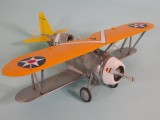
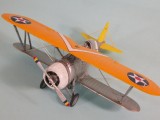

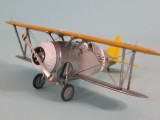
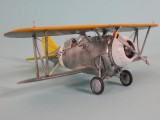




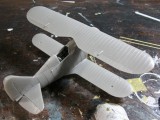







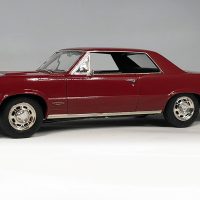

What a great-looking tub of a fighter! Nice execution of the model, and it does look like a great representation of the F2F.
Wow ! I love these fighters What prevents me from attempting them is the rigging. my hands are not as nimble as they once were. As usual great work, and history lesson
Nicely done Tom. looks really good.
Now THAT'S a flying barrel! Well done by Arma and you. I want one.
Nice Tom, Always liked yellow wings on silver paint scheme.
Beautiful build
Very well made resin model! Thanks for the hystorical insight too. Today resins are way better than we used to but still need much modelings skills to make them - Your resentation is beautiful!
A real chunky monkey. Good example of a short run resin kit, finished to a high standard.
It's exciting to see short runs bringing out new subjects to such a high standard. Fantastic subject, beautifully built.
Nicely done Tom. Did you decide not to attach the antenna or is it just not visible in the photos?
That's really nice, Tom. I was excited to see this on MM when you posted it yesterday. Thanks for dropping the loot to show us one in the flesh! That one piece cockpit looks amazing. The assembly pics are a big help towards understanding the kit. I may order one of these, along with the Iskra they offer. Was the purchase and delivery smooth?
Yet another Osprey mini book and some sharp clear photos of a Grumman classic. I like the photos of the in progress build and of course the closing color photo helps punch up the story and reaffirms the quality of the build.
Two thumbs up
Great work Tom, plus the history is a well added bonus...